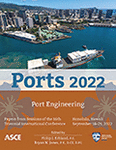Physical Modeling of Hard Structure Effects on Tsunami Force Reduction in Urban Coastal Environment
Publication: Ports 2022
ABSTRACT
Countermeasures such as seawalls and submerged breakwaters have been constructed to protect coastal communities from extreme waves, including tsunamis. Extensive studies have been performed to examine tsunami wave forces on structures, but there are few studies to evaluate the effects of defensive structures on alleviating tsunami inundations and loadings on buildings. The current study presents a large-scale experiment to investigate the performance of seawalls and submerged breakwaters against tsunami overflows by measuring the pressures and forces on the series of building arrays at the coasts. Each defensive structure effectively reduced a cross-shore tsunami force and inland flow hydrodynamics at the low water depth cases. The impulsive force on the most seaward side building was reduced by 36% when both seawalls and submerged breakwaters were installed simultaneously. However, the high water depth cases with the submerged breakwater, the impulsive forces on the most seaward building were greater than the baseline cases (absence of countermeasure structure).
Get full access to this article
View all available purchase options and get full access to this chapter.
REFERENCES
Heller, V. (2019). Tsunami Science and Engineering II. Digital Publishing Institute.
Kihara, N., Niida, Y., Takabatake, D., Kaida, H., Shibayama, A., and Miyagawa, Y. (2015). “Large-scale experiments on tsunami-induced pressure on a vertical tide wall”. Coastal Engineering, 99, 46–63.
Lee, D. (2021). Large-scale laboratory experiments and numerical modeling of wave and surge effects on residential buildings in a coastal city. Master Thesis, Hanyang University.
Li, X., and Zhang, W. (2019). “3D numerical simulation of wave transmission for low-crested and submerged breakwaters”. Coastal Engineering, 152, 103517.
Lukkunaprasit, P., and Ruangrassamee, A. (2008). “Building damage in Thailand in the 2004 Indian Ocean tsunami and clues for tsunami-resistant design”. The IES Journal Part A: Civil & Structural Engineering, 1 (1), 17–30.
Moon, W. C., Chiew, L. Q., Cheong, K. W., Tee, Y. C., Chun, J. B., and Lau, T. L. (2019). “An experimental study for estimating tsunami wave forces acting on building with seaward and landward macroroughness”. Ocean Engineering, 186, 106116.
Mori, N., Takahashi, T., and Tohoku Earthquake Tsunami Joint Survey Group. (2012). “Nationwide post event survey and analysis of the 2011 Tohoku earthquake tsunami”. Coastal Engineering Journal, 54 (1), 1250001-1–1250001-27.
Moris, J. P., Kennedy, A. B., and Westerink, J. J. (2021). “Tsunami wave run-up load reduction inside a building array”. Coastal Engineering, 103910.
Park, H., Koh, M.-J., Cox, D. T., Alam, M. S., and Shin, S. (2021). “Experimental study of debris transport driven by a tsunami-like wave: Application for non-uniform density groups and obstacles”. Coastal Engineering, 166, 103867.
Park, H., Do, T., Tomiczek, T., Cox, D. T., and van de Lindt, J. W. (2018). “Numerical modeling of non-breaking, impulsive breaking, and broken wave interaction with elevated coastal structures: Laboratory validation and inter-model comparisons”. Ocean Engineering, 158.
Rubinato, M., Heyworth, J., and Hart, J. (2020). “Protecting coastlines from flooding in a changing climate: A preliminary experimental study to investigate a sustainable approach”. Water, 12 (9), 2471.
St-Germain, P., Nistor, I., and Townsend, R. (2012). “Numerical modeling of the impact with structures of tsunami bores propagating on dry and wet beds using the SPH method”. International Journal of Protective Structures, 3 (2), 221–255.
Thomas, S., and Cox, D. (2012). “Influence of finite-length seawalls for tsunami loading on coastal structures”. JWPCOE, 138 (3), 203–214.
Tomiczek, T., Wargula, A., Lomónaco, P., Goodwin, S., Cox, D., Kennedy, A., and Lynett, P. (2020). “Physical model investigation of mid-scale mangrove effects on flow hydrodynamics and pressures and loads in the built environment”. Coastal Engineering, 162, 103791.
Xu, Z., Melville, B., Whittaker, C., Nandasena, N., and Shamseldin, A. (2021). “Mitigation of tsunami bore impact on a vertical wall behind a barrier”. Coastal Engineering, 164, 103833.
Information & Authors
Information
Published In
History
Published online: Sep 15, 2022
Authors
Metrics & Citations
Metrics
Citations
Download citation
If you have the appropriate software installed, you can download article citation data to the citation manager of your choice. Simply select your manager software from the list below and click Download.
